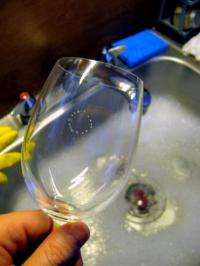Discovery in 'pop' science reveals the elegant, complex way bubbles burst (w/ Video)

On the surface of things, how a bubble bursts may seem to be a simple, unremarkable event. In the June 10th issue of Nature, engineers at Harvard report just the opposite, having uncovered the beautifully complex physics behind rupturing bubbles.
Instead of simply vanishing, a large bubble disperses into a ring of smaller bubbles. The finding could be appropriately called an advance in "pop" science.
Lead author James C. Bird, a graduate student at the Harvard School of Engineering and Applied Sciences (SEAS), and his colleagues believe they have stumbled upon a universal behavior in how bubbles pop that holds as true for suds in a sink as it does for foam in the ocean.
"In order to minimize surface area, a bubble will be nearly hemispherical when it is in contact with a solid or liquid interface," explains Bird. "We found that when these hemispherical bubbles pop, there is a two step process that can create a ring of smaller bubbles. While the resulting smaller bubbles have long been seen, until now the 'how' has never been reported in the literature."
The curved nature of the bubble plays a critical role, as the shape leads to higher pressure on the inside than on the outside of the bubble. Once the bubble opens up (i.e., bursts) it equilibrates, resulting in an inward net force due to the surface tension.
"In the first step, the forces acting on the bubble cause the film to fold in on itself as it retracts and therefore trap a pocket of air in the shape of a torus, or donut. In the second step, surface tension breaks this torus of air into a ring of smaller bubbles just like surface tension breaks a thin stream of water from a faucet into individual droplets," adds Bird.
The cascade effect is short lived, occurring no more than twice in experiments to date. "The smallest bubbles no longer form a spherical cap and reintegrate into the liquid; this is the end of the cascade."
Since the popping process happens too rapidly to be seen with the naked eye, the team used high-speed cameras to film the collapse. Based upon observing the video, they then constructed a numerical model to test and replicate their experimental assumptions.
Bird and one his co-authors, Laurent Courbin, a former SEAS research associate, were inspired to study how bubbles pop during a late night lab session. As they were investigating ways to spread bubbles on different surfaces, the pair noticed the resulting rings and decided to take a closer look.
"After that point, any time I was just walking around during a rainy day I'd look at the bubbles popping on puddles," says Bird. "When I went swimming in the ocean I would watch the bubbles on the surface and just see if I could notice the same effect. And I soon realized it was everywhere."
The physics behind bursting appears to be independent of the material of the bubble. The investigators were surprised to find that the ring effect is still seen with fairly viscous liquids like oil and even in solutions up to 5,000 times as viscous as water. Bird is anxious to study similar popping effects in more exotic materials such as molten glass, lava, and mud.
While understanding how bubbles pop may not offer any near-term applications, the researchers expect that understanding how to create small bubbles from larger ones could one day help inform a variety of fields.
"We have provided a general explanation of why these rings of smaller bubbles can be observed," says co-author Howard A. Stone, Bird's adviser and now the Donald and Elizabeth Dixon Professor in Mechanical and Aerospace Engineering at Princeton. "We think this study highlights one role for larger bubbles in aerosol formation."
It is well known that when small bubbles pop on a liquid surface tiny droplets are ejected upwards. The effect can be readily seen and felt with carbonated sodas. Bubble-mediated aerosols are also relevant to applications in health and climate.
The shooting droplets have been shown to transfer any infectious material as well as dissolved gases and salt from large bodies of water, such as the ocean, into the air. Bubbles over a few millimeters in diameter have tended to be dismissed by researchers as not producing aerosols.
The team's findings, however, may modify this belief as they further uncover how larger bubbles can be a source for these smaller, droplet-creating bubbles.
"So much of cutting-edge research can only be seen with specialized equipment. What I love about this study is that the overall effect can be seen by anyone in their kitchen," concludes Bird. "It's a relatively simple effect and yet you end up with these beautiful patterns and something that is universal."
Experiment at Home!
It’s not often that cutting-edge science can be carried out by anyone in their kitchen. Yet the inspiration for an article appearing in the June 10th issue of Nature, can be recreated quickly with some soapy water, a glass, and a thin straw.
To try this experiment, dip one end of the straw in the water to get it soapy, then place that end onto the glass while blowing into the other end of the straw in order to create a small (approximately 1 inch) hemispherical bubble onto the glass.
Now, wait for the bubble to pop, or if you get impatient, pop the bubble with your finger.
Look closely around the rim of the bubble, and you might notice a ring of smaller bubbles.
Provided by Harvard University

















